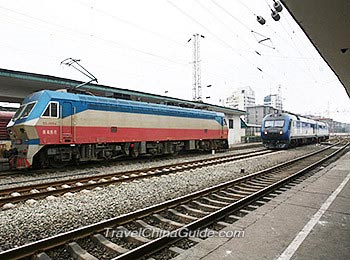China Railway History (1949-2008): Massive Construction
From 1876 to the end of 1948, there were about 14,602 miles (23,500 kilometers) of existing railways, but nearly half of them had been destroyed or damaged during the years of hostilities. Only 6,835 miles (11000 kilometers) were still in operation. Therefore, the first task for Chinese railway career was to restore the main lines and standardize their operation. By the end of 1949, Jinghan, Longhai, Zhegan, Nantongpu and Xianggui Railways were recovered, and nearly 5,143 miles (8,278 km) was open to traffic again.
 |
| Locomotives Powered by Electricity |
In 1953, China started the first five-year development plan, and the enlargement of the railway network and production of trains, specifically steam trains were given priority. In June of 1953, Chengyu Railway (Chengdu – Chonqing) was completed and put into use, and was the first railway built since the founding of new China. After that, Tiancheng, Tianlan, Lanxin railways were accomplished one after another.
By end of 1957, the newly constructed rail lines amounted to 3,790 miles (6,100 kilometers) as part of the plan, which strengthened the links between China’s interior and its east coast. It also consolidated communication with neighboring countries, such as Vietnam and Mongolia.
However, in 1958, the railway construction work was affected again and the railway operating order was disturbed gravely as a consequence of trying to achieve too much too soon. Sadly, this also resulted in an increased number of rail accidents. The major focus on coal and mineral freight disadvantaged the transportation of crops and light industrial products which had detrimental effects on the economy.
From 1961 to 1965, these problems were overcome, and the railway regained stable improvement and rectification. In 1961, Baofeng (Baoji - Fengzhou) section of Baocheng Railway (Baoji -- Chengdu) was finished as the first electrified railway.
However, China railway suffered another disaster during the decade from 1966 to 1976. Several of the most important rail terminals were blocked, and the transport and freight suspended for a while. In 1968, the whole undertaking hit rock bottom.
From 1978, large resources were put into modernization of the network, and the disproportion in the railway development was readjusted. After long-term restoration and recovery, the development of the rail system maintained a good momentum. After the Third Plenary Session in 1978, the railway electrification process was accelerated greatly. Xiangyu, Shitai, Baolan and Chengyu lines were gradually electrified. In just 24 years or so, China had constructed 41 electrified rail lines, with a total length of (11,567 miles) 18,615 km.
In general, the railway networks extended in all directions during this stage; most finished rail lines were put into operation; the passenger volume and freight forged ahead; while the railway management was inclined to be more scientific in its approach to the overall organization. The entire rail operation developed at a steady pace as it marched forward into the 21st century.![]() Further Reading on China Railway History:
Further Reading on China Railway History:
1865-1949: First Stage
2008-Present: High Speed Era